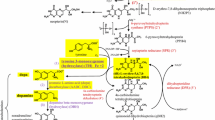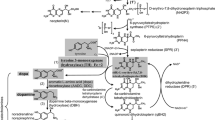Abstract
Catecholamine biosynthesis is regulated by tyrosine hydroxylase (TH) requiring tetrahydrobiopterin (BH4) as the cofactor. We found four (human TH type 1–4) and two isoforms (TH type 1 and 2) in humans and monkeys, while non-primate animals have a single TH corresponding to human TH type 1. BH4 is synthesized from GTP, and GTP cyclohydrolase I (GCH) is the first and regulatory enzyme. Mutations in GCH gene were found to cause both GCH deficiency with autosomal recessive trait and hereditary progressive dystonia with marked diurnal fluctuation (HPD) (Segawa's disease)/or DOPA-responsive dystonia (DRD) with autosomal dominant trait. When GCH activity is decreased to less than 20% of the normal value, the activity of TH in the nigrostriatal dopaminergic neurons may be first decreased resulting in decreases in TH activity and dopamine level, and in the symptoms of HPD/DRD. In contrast to HPD/DRD, juvenile parkinsonism (JP) have normal GCH activity. In Parkinson's disease (PD), GCH, TH, and dopamine in the striatum may decrease in parallel, as the secondary effects caused by cell death.
Similar content being viewed by others
Abbreviations
- BH4:
-
tetrahydrobiopterin
- GTP:
-
cyclohydrolase I
- GCH:
-
human tyrosine hydroxylase type 1–4
- hTH1-hTH4:
-
juvenile parkinsonism, JP
- MPTP:
-
1-methyl-1–4-phenyl-1,2,3,6-tetrahydropyridine
- PCR:
-
polymerase chain reaction
- PD:
-
Parkinson's disease
- RT-PCR:
-
reverse transcription-polymerase chain reaction
- TH:
-
tyrosine hydroxylase
References
Nagatsu, T. 1991. Genes for human catecholamine-synthesizing enzymes. Neurosci. Res. 12:315–345.
Nagatsu, T., Levitt, M., and Udenfriend, S. 1964. Tyrosine hydroxylase. The initial step in norepinephrine biosynthesis. J. Biol. Chem. 239:2910–2917.
Levitt, M., Spector, S., Sjoerdsma, A., and Udenfriend, S. 1965. Elucidation of the rate-limiting step in norepinephrine biosynthesis in the perfused guinea-pig heart. J. Pharmacol. Exp. Therap. 148: 1–8.
Kaufman, S. 1963. The structure of the phenylalanine hydroxylation cofactor. Proc. Natl. Acad. Sci. U.S.A. 50:1085–1093.
Kaufman, S., and Fisher, D. D. 1974. Pterin-requiring aromatic amino acid hydroxylases. Pages 285–367, in Hayaishi, O. (ed.) Molecular Mechanisms of Oxygen Activation, Academic Press, New York.
Nichol, C. A., Smith, G. K., and Duch, D. S. 1985. Biosynthesis and metabolism of tetrahydrobiopterin and molybdopterin. Ann. Rev. Biochem. 54:729–764.
Grima, B., Lamouroux, A., Boni, C., Julien, J.-F., Javoy-Agid, F., and Mallet, J. 1987. A single human gene encoding multiple tyrosine hydroxylase with different predicted functional characteristics. Nature 326:707–711.
Kaneda, N., Kobayashi, K., Ichinose, H., Kishi, F., Nakazawa, A., Kurosawa, Y., Fujita, K., and Nagatsu, T. 1987. Isolation of novel cDNA for human tyrosine hydroxylase: alternative RNA splicing produces four kinds of mRNA from a single gene. Biochem. Biophys. Res. Commun. 146:971–975.
Kobayashi, K., Kaneda, N., Ichinose, H., Kishi, F., Nakazawa, A., Kurosawa, Y., Fujita, K., and Nagatsu, T. 1988. Structure of the human tyrosine hydroxylase gene: alternative splicing from a single gene accounts for generation of four mRNA types. J Biochem. 103:907–912.
Kobayashi, K., Kiuchi, K., Ishii, A., Kaneda, N., Kurosawa, Y., Fujita, K., and Nagatsu, T. 1988. Expression of four types of human tyrosine hydroxylase in COS cells. FEBS Lett. 238:431–434.
Nasrin, S., Ichinose, H., Hidaka, H., and Nagatsu, T. 1994. Recombinant human tyrosine hydroxylase types 1–4 show regulatory properties for the natural (6R)-tetrahydrobiopterin cofactor. J. Biochem. 116:393–398.
Ichinose, H., Ohye, T., Fujita, K., Pantucek, F., Lange, K., Riederer, P., and Nagatsu, T. 1994. Quantification of mRNA of tyrosine hydroxylase and aromatic L-amino acid decarboxylase in the substantia nigra in Parkinson's disease and schizophrenia. J. Neural Transm. [P-D Sect] 8:149–158.
Ichinose, H., Ohye, T., Fujita, K., Yoshida, M., Ueda, S., and Nagatsu, T. 1993. Increased heterogeneity of tyrosine hydroxylase in humans. Biochem. Biophys. Res. Commun. 195:158–165.
Davis, G. C., Williams, A. C., Markey, S. P., Ebert, M. H., Vaine, E. D., Reichert, C. M., and Kopin, I. J. 1979. Chronic parkinsonism secondary to intravenous injection of meperidine analogues. Psychiatry Res. 1:249–254.
Langston, J. W., Ballard, P., Tetrud, J. W., and Irwin, I. 1983. Chronic parkinsonism in humans due to a product of meperidineanalog synthesis. Science 219:979–980.
Burns, S. B., Lewitt, P. A., Ebert, M. H., Pakkenberg, H., and Kopin, I. J. 1985. The chronic syndrome of striatal dopamine deficiency. Parkinsonism induced by 1-methyl-1,2,3,6-tetrahydropyridine (MPTP). New Engl. J. Med. 312:1418–1421.
Ohye, T., Ichinose, H., Ogawa, M., Yoshida, M., and Nagatsu, T. 1995. Alterations in multiple tyrosine hydroxylase mRNAs in the substantia nigra, locus coeruleus and adrenal gland of MPTP-treated parkinsonian monkeys. 4:81–85.
Nagatsu, T., Naoi, M., Niwa, T., and Yoshida, M. 1994. Pages 149–159,in Mizuno, Y., Calne, D. B., and Horowski, R. (eds.), Advances in Research on Neurodegeneration Volume 2, Birkhäuser, Boston.
Ichinose, H., Ohye, T., Matsuda, Y., Hori, T., Blau, N., Burlina, A., Rouse, B., Matalon, R., Fujita, K., and Nagatsu, T. 1995. Characterization of mouse and human GTP cyclohydrolase I genes. Mutations in patients with GTP cyclohydrolase I deficiency. J. Biol. Chem. 270:10062–10071.
Niederwieser, A., Blau, N., Wang, M., Joller, P., Atarés, M., and Cardesa Garcia, J., 1984. GTP cyclohydrolase I deficiency, a new enzyme defect causing hyperphenylalaninemia with neopterin, biopterin, dopamine, and serotonin deficiencies and muscular hypotonia. Eur. J. Pediatr. 141:208–214.
Blau, N., Ichinose, H., Nagatsu, T., Heizmann, C. W., Zacchello, F., and Burlina, A. B. 1995. A missense mutation in a patient with guanosine triphosphate cyclohydrolase I deficiency missed in the newborn screening program. J. Pediatrics 126:401–405.
Segawa, M., Ohmi, K., Itoh, S., Aoyama, Y., and Hayakawa, H. 1971. Childhood basal ganglia disease with remarkable response to L-DOPA, hereditary basal ganglia disease with marked diurnal fluctuation. Shinryo (Tokyo) 24:667–672.
Segawa, M., Hosaka, A., Miyagawa, F., Nomura, Y., and Imai, H. 1976. Hereditary progressive dystonia with marked diurnal fluctuation. Pages 215–233,in Eldridge, R., and Fahn, S. (eds.), Advances in Neurology Volume 14, Raven Press, New York.
Nygaard, T. G., Marsden, C. D., and Duvoisin, R. C. 1988. Dopa-responsive dystonia. Pages 377–384,in Fahn, S., Marsden, C. D., and Calne, D. B. (eds.), Advances in Neurology Volume 50, Raven Press, New York.
Nygaard, T. G., Snow, B. J., Fahn, S., and Calne, D. B. 1993. Dopa-responsive dystonia: clinical characteristics and definition. Pages 21–35,in Segawa, M. (ed.) Hereditary Progressive Dystonia with Marked Diurnal Fluctuation, Parthenon, Carnforth, UK.
Togari, A., Ichinose, H., Matsumoto, S., Fujita, K., and Nagatsu, T. 1992. Muttiple mRNA forms of human GTP cyclohydrolase I. Biochem. Biophys. Res. Commun. 187:359–365.
Ichinose, H., Ohye, T., Takahashi, E., Seki, N., Hori, T., Segawa, M., Nomura, Y., Endo, K., Tanaka, H., Tsuji S., Fujita, K., and Nagatsu, T. 1994. Hereditary progressive dystonia with marked diurnal fluctuation caused by mutations in the GTP cyclohydrolase I gene. Nature Genetics 8:236–242.
Nygaard, T. G., Wilhelmsen, K. C., Risch, N. J., Brown, D. L., Trugman, J. M., Gilliam, T. C., Fahn, S., and Weeks, D. E., 1993. Linkage mapping of dopa-responsive dystonia (DRD) to chromosome 14q. Nature Genetics 5:386–391.
Tanaka, H., Endo, K., Tsuji, S., Nygaard, T. G., Weeks, D. E., Nomura, Y., and Segawa, M. 1995. The gene for hereditary progressive dystonia with marked diurnal fluctuation maps to chromosome 14q. Ann. Neurol. 37:405–408.
Levine, R. A., Miller, L. P., and Lovenberg, W. 1981. Tetrahydrobiopterin in striatum: localization in dopamine nerve terminals and role in catecholamine synthesis. Science, 214:919–921.
Kettler, R., Bartholini, G., and Pletscher, A. 1974. In vivo enhancement of tyrosine hydroxylation in rat striatum by tetrahydrobiopterin. Nature 249:476–478.
Nagatsu, T. 1985. Biopterin cofactor and monoamine-synthesizing monooxygenases. Pages 325–340, in Osborne, N. N. (ed.), Selected Topics in Neurochemistry, Pergamon Press, Oxford.
Niwa, S., Watanabe, Y., and Hayaishi, O. 1985. 6R-L-erythro-5, 6, 7, 8-tetrahydrobiopterin as a regulator of dopamine and serotonin biosynthesis in the rat brain. Arch. Biochem. Biophys. 239: 234–241.
Ichinose, H., Ohye, T., Segawa, M., Nomura, Y., Endo, K., Tanaka, H., Tsuji, S., Fujita, K., and Nagatsu, T. 1995. GTP cyclohydrolase I gene in hereditary progressive dystonia with marked diurnal fluctuation. Neurosci. Lett. 196:5–8.
Fink, J. K., Barton, N., Cohen, W., Lovenberg, W., Burns, R. S., and Hallett, M. 1988. Dystonia marked diurnal variation associated with biopterin deficiency. Neurology 38:707–711.
Furukawa, Y., Nishi, K., Kondo, T., Mizuno, Y., and Narabayashi, H. 1993. CSF biopterin levels and clinical features of patients with juvenile parkinsonism. Pages 562–567,in Narabayashi, H., Nagatsu, T., Yanagisawa, N., and Mizuno Y. (eds.) Advances in Neurology Volume 60, Raven Press, New York.
Takahashi, H., Levine, R. A., Glloway, M. P., Snow, B. J., Calne, D. B., and Nygaard, T. G. 1994. Biochemical and fluorodopa positron emission tomographic findings in an asymptomatic carrier of the gene for dopa-responsive dystonia. Ann. Neurol. 35:354–356.
Williams, A., Eldridge, R., Levine, R., Lovenberg, W., and Paulson, G. 1979. Low CSF hydroxylase cofactor (tetrahydrobiopterin) levels in inherited dystonia. Lancet 2:410–411.
Bernheimer, H., Birkmayer, W., Hornykiewicz, O., Jellinger, K., and Seitelberger, F. 1973. Brain dopamine and the symptoms of Parkinson and Huntington. Clinical, morphological and neurochemical correlations. J. Neurol. Sci. 20:415–455.
Rajput, A. H., Gibb, W. R. G., Zhong, X. H., Shannak, K. S. Kish, S., Chang, L. G., and Hornykiewicz, O. 1994. Dopa-responsive dystonia: pathological and biochemical observations in a case. Ann. Neurol. 35:396–402.
Lüdecke, B., Dworniczak, B., and Bartholomé K. 1995. A point mutation in the tyrosine hyfroxylase gene asspciated with Segawa's syndrome. Human Genet. 95:123–125.
Knappskog, P. M., Flatmark, T., Mallet, J, Lüdecke, B., and Bartholomé, K. 1995. Recessively inherited L-DOPA-responsive dystonia caused by a point mutation (Q 381 K) in the tyrosine hydroxylase gene. Human Mol. Genetics 4:1209–1212.
Hirano, M., Tamaru, Y., Nagai, Y., Ito, H., Imai, T., and Ueno, S. 1995. Exon skipping caused by a base substitution at a splice site in the GTP cyclohydrolase I gene in a Japanese family with hereditary progressive dystonia/dopa responsive dystonia. Biochem. Biophys. Res. Commun. 213:645–651.
Narabayashi, H., Yokochi, M., Iizuka, R., and Nagatsu, T. 1986. Juvenile parkinsonism. Pags 153–165, in Vinken, P. J., Bruyn, G. W., and Klawans, H. L. (eds.), Handbook of Clinical Neurology Volume 49 Extrapyramidal Disorders, Elsevier, Amsterdam.
Yokochi, M., 1993. Nosological concept of juvenile parkinsonism with reference to the dopa-responsive dystonia Pages 548–552,in Narabayashi, H., Nagatsu, T., Yanagisawa, N., and Mizuno, Y. (eds.), Advances in Neurology Volume 60, Raven Press, New York.
Ichinose, H., Ohye T., Yokochi, M., Fujita, K., and Nagatsu, T. 1995. GTP cyclohydrolase I activity in mononuclear blood cells in juvenile parkinsonism. Neurosci. Lett. 190:140–142.
Nagatsu, T., Horikoshi, T., Sawada, M., Nagatsu, I., Kondo, T., Iizuka, R., and Narabayashi, H. 1986. Biosynthesis of tetrahydrobiopterin in parkinsonian human brain. Pages 223–226,in Yah, M. D. and Bergman, K. I. (eds.), Advances in Neurology Volume 45, Raven Press, New York.
Author information
Authors and Affiliations
Additional information
Special issue dedicated to Dr. Kinya Kuriyama.
Rights and permissions
About this article
Cite this article
Nagatsu, T., Ichinose, H. GTP cyclohydrolase I gene, tetrahydrobiopterin, and tysorine hydroxylase gene: Their relations to dystonia and parkinsonism. Neurochem Res 21, 245–250 (1996). https://doi.org/10.1007/BF02529141
Accepted:
Issue Date:
DOI: https://doi.org/10.1007/BF02529141




